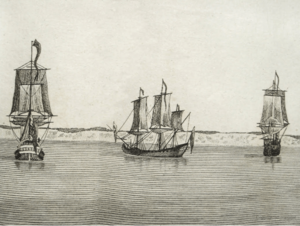HMS Pearl (1726) facts for kids
Quick facts for kids History |
|
|---|---|
| Name | HMS Pearl |
| Ordered | c. 1722 |
| Builder | Deptford Dockyard |
| Laid down | January 1723 |
| Launched | 17 October 1726 |
| Fate | Sold for breaking up on 28 June 1744 |
| General characteristics | |
| Class and type | 40-gun fifth rate |
| Tons burthen | 594 55⁄94 (bm) |
| Length |
|
| Beam | 33 ft 2 in (10.11 m) |
| Depth of hold | 14 ft (4.3 m) |
| Sail plan | Full-rigged ship |
| Complement | 190 |
| Armament |
|
HMS Pearl was a 40-gun warship of the Royal Navy. It was known as a fifth rate ship, meaning it was a medium-sized warship. Pearl played a part in the War of Jenkins' Ear, a conflict between Britain and Spain. It was also one of the ships sent with Commodore George Anson on his famous voyage around the world. During this trip, the ships aimed to attack Spanish areas in the Pacific Ocean.
Building and First Journey
The order to build Pearl was given around 1722. It was constructed at Deptford Dockyard in England. The ship was based on a design from 1719. It was laid down, meaning construction began, in January 1723. The ship was officially launched into the water on 17 October 1726. Building Pearl cost about £6,376. In 1727, the ship was ready for duty and Captain Sir Hugh Middleton took command.
Life at Sea

Captain Sir Hugh Middleton's time in charge was short. He faced a naval trial and was removed from his position in October 1727. Captain Samuel Pitman took over command of Pearl in November 1727. He sailed the ship to the Leeward Islands, a group of islands in the Caribbean Sea. Captain Pitman sadly died in October 1728.
In 1729, Captain John Trotter became the new commander. Pearl remained in the Leeward Islands. By 1731, Captain FitzRoy Henry Lee was in charge. He sailed Pearl to Guinea in West Africa later that year. The ship then returned to Britain in 1732.
While in Britain, Pearl had some repairs done at Woolwich Dockyard from January to April 1733. After these repairs, Captain Trotter took command again. Pearl went back to the Leeward Islands. It returned to Britain once more for bigger repairs at Sheerness from October 1737 to May 1738. Captain Trotter had left the ship in 1736.
By mid-1738, Pearl was back in service under Captain Edward Legge. When the War of Jenkins' Ear began, Pearl left England on 23 July 1739. It sailed with Admiral Edward Vernon's group of ships towards Lisbon, Portugal.
In June 1740, Captain Matthew Michell took command. Pearl was then assigned to Commodore George Anson's group. Their mission was to attack Spanish areas in the Pacific Ocean. This long journey faced many problems. Many crew members and commanders died from a disease called scurvy.
Captain Dandy Kidd took over command by December 1740. However, he died in January 1741. Captain George Murray then became the commander. On 10 April 1741, Pearl lost contact with the main group of ships. It eventually returned to Britain. In July 1742, Pearl was in Barbados before being ordered back to Britain.
The Admiralty decided on 22 April 1743 that Pearl should be taken apart and a new ship built. However, this order was changed on 16 June 1744. Instead, Pearl was sold on 28 June 1744 for £266.

